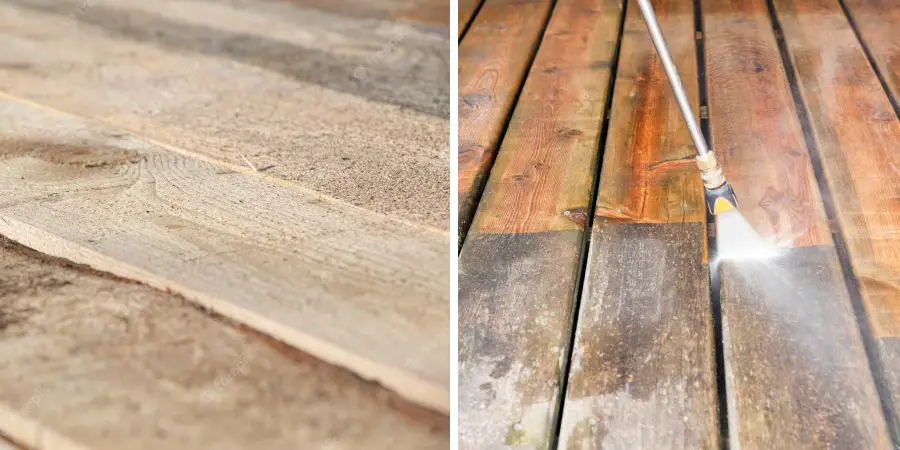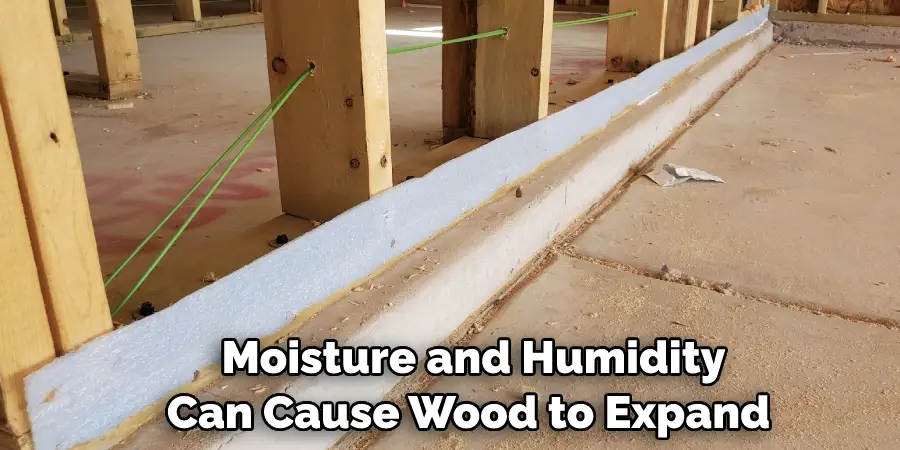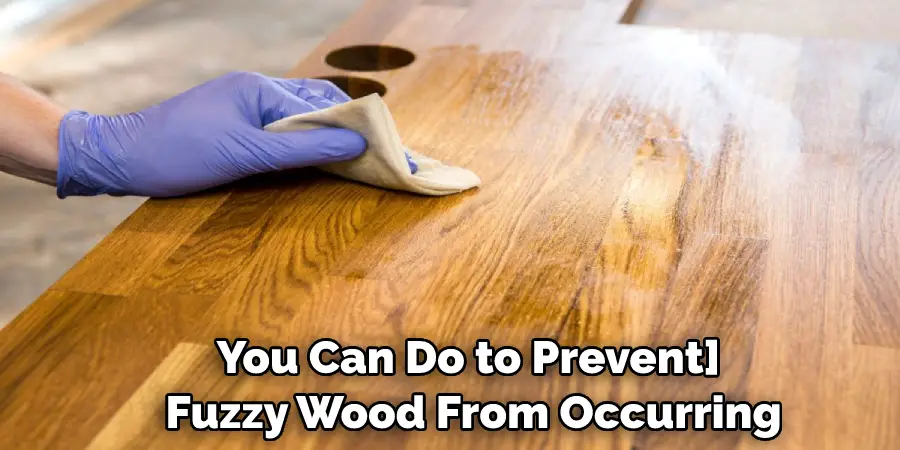Have you ever come across a piece of wood that looks worn out and fuzzy? If so, there’s no need to worry, as it can be fixed quite easily with the right tools. In this blog post, we’ll share our top tips for restoring that wood to its former glory by fixing any fuzziness or damage. Whether your project is large or small, if you follow these simple steps, you’ll soon have restored the natural beauty of your wooden item in no time at all.

If you’re looking for a way to fix faded or fuzzy wood, then you’ve come to the right place. Over time, wooden furniture and other wooden items can become worn, scratched, and faded due to extensive use or direct exposure to sunlight. Fortunately, there are several simple steps that you can take in order to restore the original look of your wood–from sanding down its surface to finishing it with a sealant. Here we will discuss these methods on how to fix fuzzy wood in detail so that you can have your wood looking great once again!
What Causes Problems in Fuzzy Wood?
1. Improper Sanding
If the wood has not been properly sanded, it can cause the surface to become fuzzy or rough. Also, if the sandpaper used is too coarse, it can damage the wood and make it more vulnerable to future problems.
2. Moisture
Exposure to extreme moisture can cause wood to become fuzzy or rough as well. If this happens, it’s important to assess the situation and take steps to dry out the wood before attempting to repair it. So, if you suspect your wood has been exposed to too much moisture (whether from a water leak or too much humidity in the air), make sure to dry it out before attempting repairs.
3. Poor Finish
If the finish applied on the wood is not of good quality, this can cause problems with fuzziness and roughness. Therefore, it is important to make sure the finish you use is appropriate for the project.
4. Damage
Finally, some types of damage can cause wood to become fuzzy or rough. This may be due to wear and tear over time or an accident such as dropping a heavy object on the wood. In any case, it’s important to first assess the type and extent of damage before attempting to fix it.

5. Insect Infestation
Some types of wood-boring insects can also cause damage that leads to a fuzzy or rough surface. If you suspect your wood has been infested, it’s important to identify the type of insect and take appropriate steps to get rid of them before attempting repairs.
Once you have identified the cause, you can start working on how to fix fuzzy wood. Depending on the cause of the problem, you may need to do a few different things. In some cases, simply sanding and refinishing the wood will be enough; in others, more drastic measures may be necessary.
15 Tips On How to Fix Fuzzy Wood
Now that you know what causes problems in fuzzy wood, it’s time to learn how to fix them. Here are some tips to help you restore your wood back to its original condition:
1. Sand Gently
If the wood has been improperly sanded or is showing signs of wear and tear, start by gently sanding the wood to remove any rough surfaces. Use fine-grit sandpaper and apply even pressure while you work.
2. Clean Carefully
Once the wood is smooth, use a cloth or sponge dampened with warm soapy water to clean the surface of dust and debris. Gently scrub in small circles until it is free of dirt and grime. Also, you have to make sure that all the dirt and debris are gone, as it can ruin the finish of your wood.
3. Oil Thoroughly
To keep the wood from drying out, apply a coat of oil or wax to it with a lint-free cloth. This will help seal in moisture and prevent fuzzy wood from developing further. Also, make sure to oil the wood regularly – at least once a month – to keep it looking refreshed and healthy.

4. Polish Regularly
Polishing the wood on a regular basis is another effective way to maintain its smooth surface and prevent any fuzziness from developing. Use a quality wood polish of your choice and apply it with a clean, soft cloth.
5. Fill Any Imperfections
If the wood has some minor scratches or dents, you can use a wood filler to fill them in. After selecting a product suitable for your project, carefully apply it according to the directions and allow it to dry before sanding it down with fine-grade sandpaper.
6. Refinish Regularly
To make sure your wood stays in top condition, consider refinishing it every couple of years. Start by lightly sanding the surface and then applying a fresh coat of paint or stain to bring out its natural beauty.
7. Dust Regularly
Another way to keep fuzzy wood from forming is to dust the surface on a regular basis with a microfiber cloth. This will help to remove any dirt, dust, and debris that can cause damage and discoloration over time.
8. Avoid Direct Sunlight
Exposure to direct sunlight can dry out wood quickly and cause it to crack or splinter. To keep your wood looking its best, try to keep it away from direct sunlight. So be careful when placing furniture, rugs, or other items near windows.
9. Humidify Your Home
Research has shown that increasing the humidity levels in your home can help to reduce fuzzy wood problems. Consider investing in a humidifier to keep the air moist and protect your wood from damage.

10. Choose Proper Storage
When storing wood, be sure to choose a cool, dry place that is free from moisture and direct sunlight. This will help to keep it from drying out and developing fuzzy wood. Make sure to stack the wood carefully so that it does not warp or crack.
11. Protect From Pests
Another major cause of fuzzy wood is the presence of pests like termites, ants, and other insects. To help prevent this from occurring, use an insect repellent around any areas where you are storing wood.
12. Protect With Oils
Another way to protect the wood from damage is to use natural oils like lemon, jojoba, or mineral oil on the surface. These are much gentler on wood than synthetic products and won’t cause any damage. Be sure to apply the oil in a thin layer and then buff it off with a dry, clean cloth for the best results.
13. Use Soft Bristles
When cleaning wood surfaces, it’s important to use a soft brush with natural bristles. This will help keep the wood looking its best and avoid any damage that could lead to fuzzy wood. Always make sure to use a gentle, circular motion when scrubbing the surface.
14. Avoid Moisture
Excessive moisture and humidity can cause wood to expand, creating fuzzy wood in the process. To avoid this issue, be sure to keep your home free of excess moisture and use fans or dehumidifiers if necessary.

15. Seek Professional Help
If all else fails and your wood still has fuzzy patches, then it may be time to contact a professional. They will be able to assess the damage and advise on the best course of action – whether that’s replacing certain pieces of wood or performing a complete refinishing job.
Following these tips should help you keep your wood looking its best and avoid any fuzzy patches from forming. With regular maintenance and care, you can ensure that your wood is always in top condition and ready to make a great impression.
Frequently Asked Question
What Precautions Should I Be Taking When Fixing Fuzzy Wood?
When fixing fuzzy wood, it is important to take proper safety precautions. Always wear a dust mask, safety glasses, and gloves when working with wood, as sawdust and other particles can irritate your skin, eyes, and lungs. Make sure that you are using the correct tools for the job, such as a belt sander for larger areas of wood and a palm sander or orbital sander for smaller areas. When sanding, it is important to move the sander in small circles and use light pressure to avoid damaging the wood. Additionally, when using stain and varnish, make sure you are in a well-ventilated area and wear a mask and gloves to protect yourself from the fumes.
What Is the Best Way to Fix Fuzzy Wood?
The best way to fix fuzzy wood is to use sandpaper of various grits, starting with a coarse grit such as 80 or 100, followed by medium grits such as 180 and 220. Using a belt sander or palm sander, sand in small circles, working your way around the wood until you have achieved a smooth surface. After sanding, use a vacuum to remove any dust and debris before applying a finish such as a stain and a varnish. Make sure that you are using the correct products for the job and follow all label instructions carefully. Additionally, it is best to test any products on a small area of wood before applying them to the entire surface.
Can I Fix Fuzzy Wood Without Sanding?
Unfortunately, sanding is usually necessary in order to fix fuzzy wood. However, you may be able to reduce the amount of sanding needed by using wood conditioner or a special cleaning product. Additionally, if the wood is not too badly damaged, you may be able to use steel wool and wax-based furniture polish to make it look more presentable. It is important to test any products on a small area of wood before applying them to the entire surface.
Is It Possible to Prevent Fuzzy Wood From Happening in the First Place?

Yes, there are a few things that you can do to prevent fuzzy wood from occurring. If possible, try to avoid using too much pressure when cleaning or moving furniture, as this can cause scratching and damage to the surface of the wood. Additionally, make sure that you are using the correct cleaning products for the type of wood you are dealing with. Finally, always wipe up any spills as soon as possible to prevent moisture from seeping into the wood and causing damage.
What Is the Best Way to Clean Fuzzy Wood After Fixing It?
The best way to clean fuzzy wood after fixing it is to use a soft cloth and gentle cleaning products, such as mild soap and water. Avoid using any abrasive cleaners or sponges, as these can damage the wood. Additionally, make sure that you are wiping up any spills as soon as possible in order to prevent permanent staining from occurring. Finally, if you have applied a finish such as a stain and varnish, make sure that you are using the correct products for cleaning and polishing the wood.
I Have Tried Sanding, But My Fuzzy Wood Is Still Not Smooth. What Should I Do?
If sanding has not been able to remove all of the fuzz from your wood, it may be time to consider refinishing the surface. This involves sanding down the wood again, followed by applying a new finish such as a stain and varnish. Make sure that you are using the correct products for the job and follow all label instructions carefully.

Conclusion
In conclusion, fixing fuzzy wood is achievable and with a few simple techniques, you can make your furniture look as good as new. By sanding away the fuzz, cutting off loose ends, and smoothing any rough edges, you can have the smooth and even surface you desire. As the wooden surface begins to age, it will inevitably become more prone to damage – but that doesn’t mean it should be neglected!
A few touch-ups here and there will always help keep your furniture looking its best and extend its life. Now you know how to fix fuzzy wood! Remember: to properly care for your wooden furniture it is important that you provide regular maintenance and restore small damages right away. With these steps in mind, you can easily fix fuzzy wood and prevent further damage.
